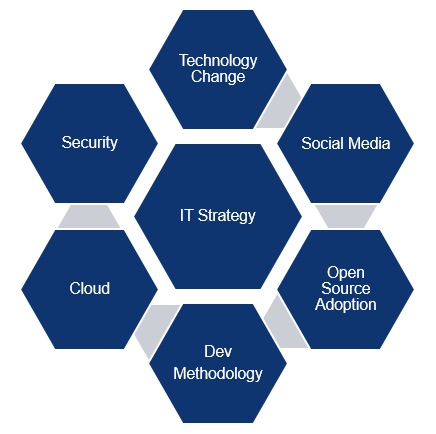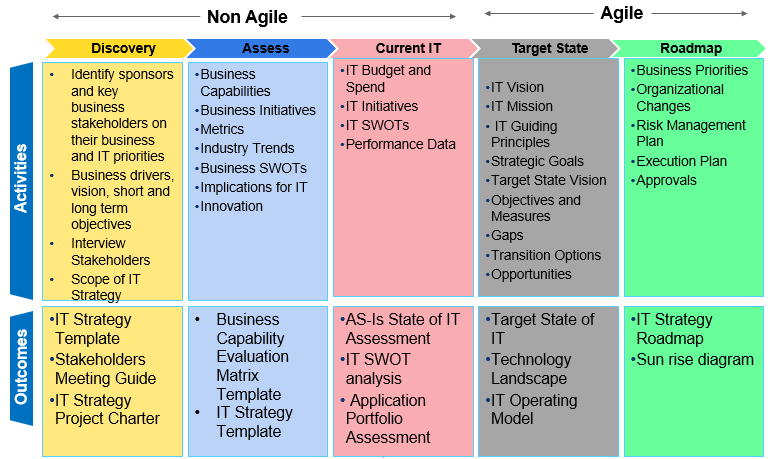IT Strategy Approach For Digital Enterprise
This article outlines some of the elements of developing and implementing an IT strategy that works well witih an enterprise working in Agile methods.
Join the DZone community and get the full member experience.
Join For FreeIntroduction
Today, more than ever before, and often without noticing it, technology touches every part of our lives. The adoption of next-generation technologies, automated tools, Agile and DevOps methodologies by an organization made the role of IT as a crucial factor for the business transformation. The ability to harness these powerful technical capabilities and use them to support the business is both challenging and rewarding. Achieving synergy between people, processes, and technology is not an easy task by any measure. The CIOs of organizations have to formulate a modern IT strategy that is in line with the new realities.
The IT strategy is also called a technology strategy. It guides how IT helps businesses to win in their chosen business context. In the first place, the business needs of IT to be successful are:
- Agility for changing business needs and consumer behavior changes
- Scale to handle increasing demands on business growth
- Security in all its operations
- Ability to understand and anticipate organization customer needs
- Manage a large variety and velocity in customer growth
As part of engaging with various customers in defining the IT strategy, the author's viewpoint is many of the IT strategy initiatives are aspirational and unachievable goals and strategies. Organizations simply document the IT strategy artifacts and shelf them or discontinued in the middle of the implementation. In out opinion, the drafting of IT strategy should be consistent and actionable.
This article focus on methodology to be adopted in defining the IT strategy in the digital era in an Agile way and the best practices that can help organizations to be more successful.
Overview of IT Strategy
IT strategy is a plan to create an Information Technology capability for maximizing the business value for the organization. The IT capability is the organization's ability to meet business needs and improve business processes using IT-based systems. The objective of the IT strategy is to spend the least amount of resources and generates better ROI. It helps in setting the direction for the IT function in an organization.
A successful IT strategy helps the organization to reduce the operational bottlenecks, realize TCO, and derive value from technology.
The following are the drivers for the IT strategy definition in the Digital Era:

- Technology Change: Change in technology is constant. The adoption of new technologies in near real-time is mandatory for the organization to sustain in the market.
- Social Media: Social media is a quick way of sharing information with the end users. It is very critical in developing a solution for the business problem. This feature needs to be integrated with the IT strategy definition.
- Open Source Adoption: Evaluate the usage of Open Source technologies for both software and hardware to cut the dollar spending by an organization.
- Cloud: Almost all the organizations are moving from On-premise to Cloud for better TCO. Adopting different models like SaaS, PaaS, and IaaS across the IT portfolio.
- Security: It plays a crucial role in securing the organization's assets and business. You need to decide which to guard against and how much to spend to stay safe. Factors like Performance, Quality, Reliability, and Scalability are the most fundamental aspects to run the organization smoothly.
- Development Methods & Tools: Adoption of Agile and DevOps helps organizations establish rapid development model and support the business change.
- Automation: Robotic Process Automation for the automation of the process need to be verified. Explore the usage of technologies like Machine Learning, Virtual Reality, and Augmented Reality to be the part of IT portfolio of an organization.
- Mobility: This helps the online/mobility services of business processes to enable easy access and provisioning of process for customers, service providers, and business users.
All the above drivers demand the Agile IT strategy for an organization rather than an Ivory Tower and traditional strategy.
Agile IT Strategy Methodology
Agile IT strategy is developed based on the key parameters like, where the organization today, where it want to be in the next 3 to 5 years. The critical elements of the IT Strategy definition like business drivers, IT drivers, business imperatives, business capability driven by IT capability are considered.
It addresses the increasing digitization and unpredictability in many industry domains. It provides the speed to IT strategy work eliminating external consultants.
Broadly, an IT strategy has five phases covering Discovery, Assess, Current IT, Target IT, and Roadmap.
The Discovery, Assess, and Current IT phases have to be executed in a sequential way. However, The Target State IT and Roadmap are executed in an agile way.
The idea of Agile IT Strategy is to keep the annual and multiyear plan usual, insert the regular frequent check-ins along the way. Revisit IT Strategy for every quarterly or every six months to ensure that optimal business value created. The Strategy team discuss technology changes and industry trends and adjust the roadmap accordingly.
Below are the high-level phases that we adopted for the definition of Agile IT Strategy for an organization. 
- Discovery: Identify the key stakeholders, conduct the interviews, and determine the mandate for the definition of IT Strategy. Spend significant amount of time with key stakeholders to understand the requirements of the IT strategy. Address the concerns of stakeholders who have the most power and who affected more in the IT strategy development effort. As part of this phase, discuss stakeholder concerns, information needs, and desired uses of IT strategy. IT Strategy project development charter shall be finalized during this phase.
- Assessment: Identify key business drivers and review business capabilities and business initiatives. Drivers are events, conditions, and decisions outside the realm of IT that affect the IT strategy. They can exist within an organization or in the external environment. A business capability is an abstraction that helps describe what the organization does to achieve its vision, mission, and goals. Business capabilities are the building blocks of the organization. Perform business SWOT analysis helps to identify the trends that must leverage and risks that must be mitigated. Listing of IT Metrics to measure the performance of business strategy done during this phase.
- Current State IT: Assess current “As Is” case covering all business operations, processes, and services. Also, business applications/solutions and technical infrastructure architecture landscape. Examination of the current operations line, services, products, and infrastructure Assess IT organization structure and Human Resources to re-align to organization cater and growth. Understand current disaster recovery and business continuity covering enterprise-level along with IT practices related to Disaster Recovery and Business Impact Analysis. Leverage the analysis tool to examine current implemented solutions cross-organization – like SWOT or any other tools.
- Target State IT: In this phase, understand the organization's future growth plan and business strategy. Revisit IT vision, mission, and guiding principles of an organization, if already defined. Identify the IT improvement opportunities with an alignment toward organization business strategy. Define demand projections covering different techniques for effective and efficient business operations. It enhances the development of target IT architecture while covering the best opportunities and utilization of following key focus areas,
- Business process automation
- Compliance and assurance
- Social media
- Digital Transformation
- Intelligence Solutions and Data Management
- Cloud and Mobility
- IT Security
- Innovative Trends, internal and external benchmarks
- External trends and influences either globally or locally
As part of the target state IT, revisit IT organization, roles, and responsibilities in line with organization practices and framework. Best practices and latest technology and market trends in technology horizon with specific regard to domain.
- Roadmap: In this phase, develop the IT strategy roadmap in the executive level as well as detail level. The roadmap shall focus on the defined key focus areas and IT strategic pillars. It also addresses the implementation plan of the IT strategy spanning in the short term, midterm, and long term with prioritization of initiatives, objective description, cost along with key business benefits and success factors.
Best Practices for Developing an Agile IT Strategy
A clear Agile IT Strategy is the most important activity of the CIO of an organization to achieve the business goal and benefits to the business. IT Strategy is a continuous process; it is not a one-time activity. IT strategy needs to adapt to changing business needs and customer demands. Visit strategic planning and its implementation status frequently.
The following are the best practices for developing Agile IT Strategy:
- Involve business stakeholders as part of the definition of Agile IT Strategy
- Always craft the IT Strategy plan that is actionable and conduct the check regularly
- Use common language and teams that are domain-specific and used across the organization
- A successful Agile IT strategy is always defined at the CIO level
- Every strategy pillar must support organizational goals. Develop a small, select set of goals that drive the organization towards vision
- The implementation plan should reflect current realities and constraints
- Conduct measurement checks to ensure progress toward goals
Acknowledgments
The author would like to thank Kiran M R and Raju Alluri of Wipro Digital Architecture Practice of Wipro Ltd for giving the required time and support in many ways in bringing up this article.
Disclaimer
The views expressed in this article/presentation are that of authors and Wipro does not subscribe to the substance, veracity or truthfulness of the said opinion
Opinions expressed by DZone contributors are their own.

Comments